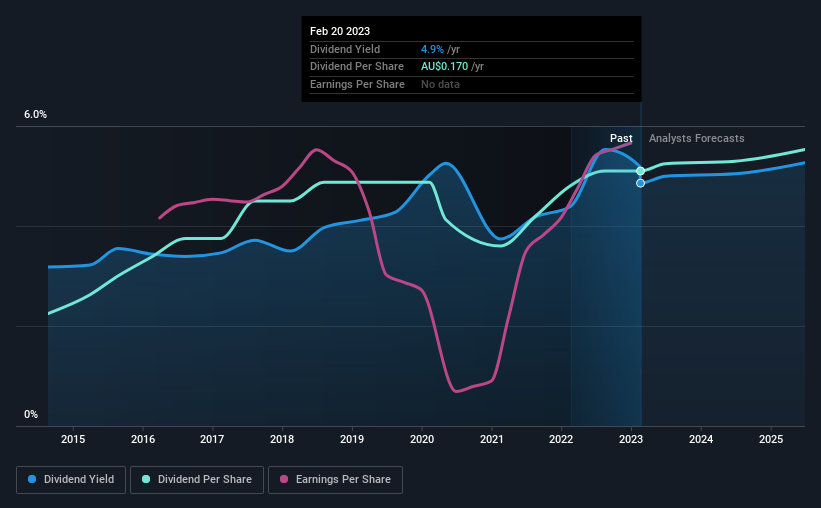Orora Limited (ASX:ORA) has announced that it will be increasing its periodic dividend on the 12th of April to A$0.085, which will be 6.3% higher than last year's comparable payment amount of A$0.08. This will take the dividend yield to an attractive 4.9%, providing a nice boost to shareholder returns.
View our latest analysis for Orora
Orora's Earnings Easily Cover The Distributions
If the payments aren't sustainable, a high yield for a few years won't matter that much. Prior to this announcement, Orora's dividend was making up a very large proportion of earnings and perhaps more concerning was that it was 100% of cash flows. Paying out such a high proportion of cash flows can expose the business to needing to cut the dividend if the business runs into some challenges.
Over the next year, EPS is forecast to expand by 9.0%. Assuming the dividend continues along the course it has been charting recently, our estimates show the payout ratio being 70% which brings it into quite a comfortable range.

Orora's Dividend Has Lacked Consistency
Even in its relatively short history, the company has reduced the dividend at least once. If the company cuts once, it definitely isn't argument against the possibility of it cutting in the future. Since 2015, the annual payment back then was A$0.075, compared to the most recent full-year payment of A$0.17. This works out to be a compound annual growth rate (CAGR) of approximately 11% a year over that time. Orora has grown distributions at a rapid rate despite cutting the dividend at least once in the past. Companies that cut once often cut again, so we would be cautious about buying this stock solely for the dividend income.
The Dividend's Growth Prospects Are Limited
Growing earnings per share could be a mitigating factor when considering the past fluctuations in the dividend. Earnings has been rising at 3.6% per annum over the last five years, which admittedly is a bit slow. Earnings are not growing quickly at all, and the company is paying out most of its profit as dividends. That's fine as far as it goes, but we're less enthusiastic as this often signals that the dividend is likely to grow slower in the future.
The Dividend Could Prove To Be Unreliable
Overall, we always like to see the dividend being raised, but we don't think Orora will make a great income stock. The payments are bit high to be considered sustainable, and the track record isn't the best. This company is not in the top tier of income providing stocks.
Investors generally tend to favour companies with a consistent, stable dividend policy as opposed to those operating an irregular one. Meanwhile, despite the importance of dividend payments, they are not the only factors our readers should know when assessing a company. Taking the debate a bit further, we've identified 2 warning signs for Orora that investors need to be conscious of moving forward. Is Orora not quite the opportunity you were looking for? Why not check out our selection of top dividend stocks.
New: AI Stock Screener & Alerts
Our new AI Stock Screener scans the market every day to uncover opportunities.
• Dividend Powerhouses (3%+ Yield)
• Undervalued Small Caps with Insider Buying
• High growth Tech and AI Companies
Or build your own from over 50 metrics.
Have feedback on this article? Concerned about the content? Get in touch with us directly. Alternatively, email editorial-team (at) simplywallst.com.
This article by Simply Wall St is general in nature. We provide commentary based on historical data and analyst forecasts only using an unbiased methodology and our articles are not intended to be financial advice. It does not constitute a recommendation to buy or sell any stock, and does not take account of your objectives, or your financial situation. We aim to bring you long-term focused analysis driven by fundamental data. Note that our analysis may not factor in the latest price-sensitive company announcements or qualitative material. Simply Wall St has no position in any stocks mentioned.
About ASX:ORA
Orora
Designs, manufactures, and supplies packaging products and services in Australia, New Zealand, the United States, and internationally.
Flawless balance sheet with low risk.
Similar Companies
Market Insights
Weekly Picks


Crazy Undervalued 42 Baggers Silver Play (Active & Running Mine)


Fiducian: Compliance Clouds or Value Opportunity?

Willamette Valley Vineyards (WVVI): Not-So-Great Value
Recently Updated Narratives


ADNOC Gas future shines with a 21.4% revenue surge

Watch Pulse Seismic Outperform with 13.6% Revenue Growth in the Coming Years

Significantly undervalued gold explorer in Timmins, finally getting traction
Popular Narratives


MicroVision will explode future revenue by 380.37% with a vision towards success


NVDA: Expanding AI Demand Will Drive Major Data Center Investments Through 2026





